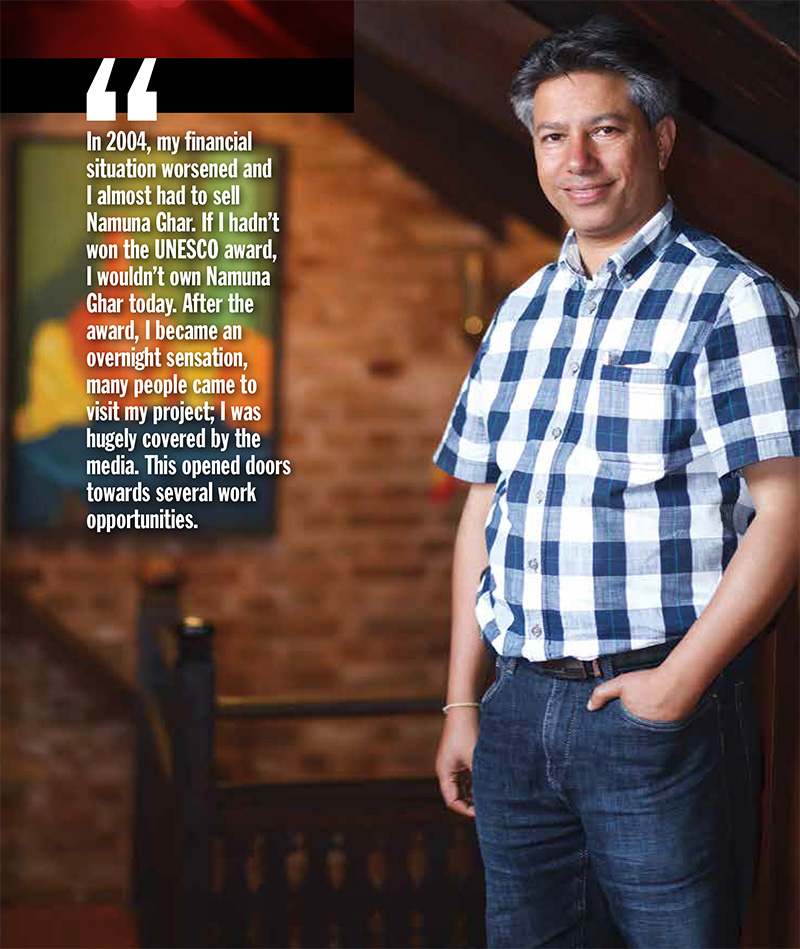
Rabindra Puri is renowned for restoring the 140-year-old crumbling Newari house of Bhaktapur into Namuna Ghar two decades ago. Namuna Ghar, which was once in such shambles that it had been relegated to being used as a chicken coop, is now used as a residence. Puri, an architect, sculptor, artist and now a heritage conversationalist, is the first Nepali to be honoured with the UNESCO Asia Pacific Heritage Award for Conservation.
It’s one thing to talk about preserving traditional buildings; it’s another to actually restore a traditional building from the past and make it a habitable home. Puri is doing just that since 1999. So far he has restored and/or built 100 traditional buildings and aims to reach a figure of 1000. In a detailed conversation with Ankita Jain of B360, Rabindra Puri talks about the necessity of restoring traditional buildings, the poor image of traditional architecture in the country, and the importance of Vastu. Excerpts from the interview:
Please comment on the changing practices in housing and the transforming role of architects in it.
Traditional architecture is ecological and healthy. It is not necessary that the same design and principle should be followed; fusions are always welcomed and appreciated. But the only fact which saddens me is that Nepali architects who study in foreign countries come here and try to replicate foreign architectural styles. If the architects had studied native architectural style and worked on improving given design then I believe it would have become a trend. In this country with its beautiful landscape, creating a concrete jungle saddens me the most. I am neither an engineer nor an architect; I couldn’t stand this state of our traditional architecture and ventured into this field. Moreover, I am not so happy with modern architects. The modern architects should know about the diversity in architectural style rather than replicating foreign designs. Instead they should explore traditional housing designs belonging to different ethnic groups and add a touch of modernity to it.
Is readapting old buildings the way forward for adaptive reuse?
I have been trying to create awareness about the possibility of readapting old buildings through Namuna Ghar. When I restored this house, I wanted to show that modern facilities can be added to this kind of traditional buildings as well. Today Namuna Ghar is a model house for everyone who thinks old buildings can’t be reused while keeping modern comforts intact.
I started the restoration work 20 years back and while working on this I never thought the work will be this impactful. Currently, the tendency of building traditional houses is increasing even in the capital city.
What are the challenges of traditional architecture?
During that restoration work of Namuna Ghar, people were skeptical about the construction of washrooms, wiring and plumbing. But I proved them wrong by proper planning and technology. Also, increasing height is a major problem, rest everything is possible. But the real charm lies in its original beauty. Not everything can be played with. Foreigners prefer to stay in traditional houses than in the concrete buildings which are the same across the world.
Could you give us some examples of your work fusing old with new?
I have renovated traditional buildings for new purposes – while the exterior pertains to the old style, the interior is modernised to suit individual needs. I believe in incorporating locally available resources with traditional norms and values. It’s been more than two decades since I started renovating Bhaktapur’s historic buildings as well as building new ones that adhere to local building techniques. To date, I have worked on a hundred projects, including renovating old houses, community schools and libraries to reflect traditional architecture.
Tell us about the UNESCO Asia Pacific Cultural Heritage Conservation Award you received in 2004…
When restoration work on Namuna Ghar began in 1999, I and my team took particular care to ensure that we preserve as much as possible of the original building. In fact, we were able to complete the project using almost 80% of the original structure and materials. And this helped me in winning the UNESCO Asia Pacific Cultural Heritage Conservation Award in 2004.
I was highly satisfied constructing this house that I bought three more houses. And my savings were slowly going down. In 2004, my financial situation worsened and I almost had to sell Namuna Ghar. If I hadn’t won the UNESCO award, I wouldn’t own Namuna Ghar today. After the award, I became an overnight sensation, many people came to visit my project; I was hugely covered by the media. This opened doors towards several work opportunities. From Soaltee to a simple man, I got work from many types of people. I had earned so much that when I reached 40, my turnover touched 20 crores. I had also invested in old houses which cost me less, for instance, Namuna Ghar cost me Rs seven lakhs. Considering the fund required for restoration, I donated 50% of my property to my foundation. Today all my conservation and social work are funded by my foundation.
How can sustainable heritage development become a model in the country?
I won’t be wrong if I say I am the pioneer for sustainable heritage development. And I strongly believe that if you don’t put heritage in business it won’t be sustainable. Traditionally built hotels, restaurants and museums convey success stories. Also, the houses which I restored in Kathmandu and Patan are in high demand for rental.
Tell us about your dream of making Panauti a traditional architectural town by 2030, and why Panauti?
Though I worked in Kathmandu, Bhaktapur and Patan in several restoration projects but my ambition wasn’t fulfilled. I wanted to preserve an entire town with traditional architecture. I looked for a suitable town and Panauti was the most viable of all. I have been actively working towards this project for a decade now. Within this time frame, we have been successful in constructing almost 10 buildings. Also, we are supported and encouraged by the community here. Though my target is 2030, even today many tourists go there to feel that traditional vibe. Currently, I am doing three kinds of work in Panauti. First, restoring old buildings; second, converting visually unappealing buildings into traditional beauty, and lastly, constructing new buildings in traditional style. I have also constructed two library buildings of READ Nepal in Panauti, and a vocational school. These buildings will add value to the existing. There are 700 buildings to be restored in Panauti. Also, the buildings I had restored or constructed were not affected by the earthquake, not even with a single hairline crack.
What kind of support are you getting from the government?
If the government had started to build such structures, there would be nothing better. The commissions, corruption, and under the table payments is hampering not only my sector but every sector possible. The work I do should be promoted by the government but the policies are such that if even someone wants to help, they are bound by limitations. This is why working from the grass root level is challenging. On the other hand, the cement industry is influencing policies majorly. More than working for the country, the policymakers are concerned about their cut and commissions. While I am trying to build government schools in traditional style, the government is constructing concrete buildings.
Can you also share with us about The Museum of Stolen Art?
As a conservationist, I see two major problems in the country. One is heritage preservation and the other is art theft. Heritage preservation has slowly gained momentum and I believe art theft will be hugely highlighted through The Museum of Stolen Art. About 36 kilometres south-west of Kathmandu, in Panauti, this ambitious project will house replicas of 50 of Nepal’s lost artworks dating back to the 7th century. When Nepal opened its doors to foreign visitors in the 1950s, its cultural heritage garnered great interest and a marketplace developed, fed by hundreds of sculptures smuggled out of Nepal.
It took me more than four years of research before starting working on the project. I studied thousands of pictures of the stolen images before deciding on the ones that would be a part of the museum. We decided based on the sculpture’s value and artwork. Of the completed replicas included are the Uma Maheshor from the 8th Century, Female Devotee from the 7th Century and the 18th Century Female Divinity sculpture. I and my team will try to represent the sculptures in a way that touches every Nepali’s heart. The Museum of Stolen Art will showcase what we have lost and also incite the feeling of what we should do to preserve what we have now. The museum will be open for public probably next year.
How are you filling the generation gap in heritage conservation?
Talking about my own experience, as the number of projects grew, the challenges took a different shape. The money was there, the knowledge was there, but people who would implement this vision became the missing pieces of the puzzle. Bhaktapur, the ancient city of artisans, did not produce enough artists as the profession failed to attract young people. Hence, the Nepal Vocational Academy was born out of necessity. Built in Panauti, Nepal Vocational Academy aims to transfer traditional knowledge to the new generation. The academy has given many the skills which they have been able to turn into a profession. Also, we offer them guaranteed job placement after the training. This is great for a lot of boys because most of them come from financially weak backgrounds. The academy also has a hostel facility for financially weak students. Along with the training, the academy provides free formal education. We want to give them a skill which will help them earn money and also help the country preserve its traditional art. Since, there is so much demand for these artisans and not many are available, I am opening one more academy in Bhaktapur.
What are your views on Vastu Shastra?
Vastu is an integrated part of every traditional architectural design. Though the new generation does not believe in it but Vastu is a proven science. I have also been reading and practically implementing Vastu to boost positive energy in the house. After a couple of years, I am planning to pen down a book on Vastu Shastra which will answer the choicest questions of the younger generation with relevance.





